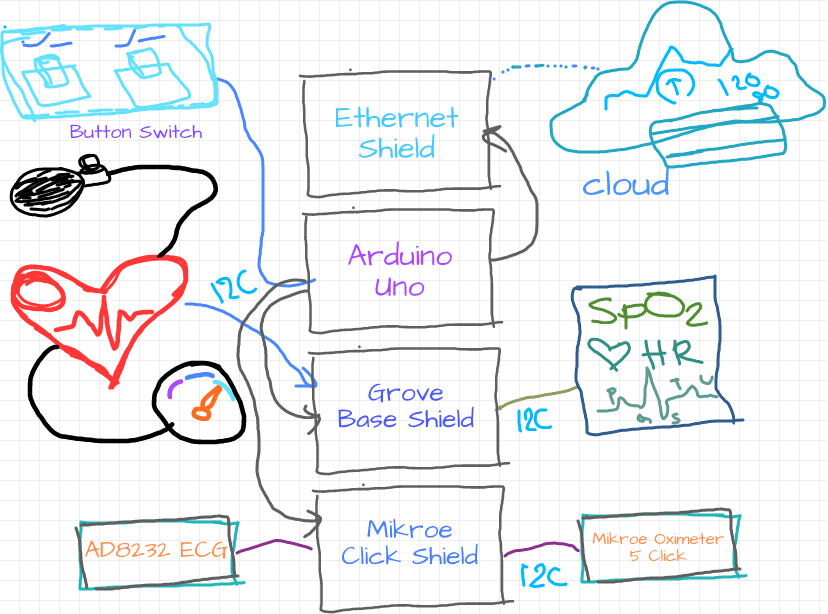Table of Contents
- Introduction
- What is Remote Patient Monitoring
- Why I am working on this
- What will the features of my system
- Components I will use
- Block Diagram
Hi all, I am very excited to be a sponsored challenger for the Summer of Sensors Design Challenge. Thanks to the judges for selecting me as a sponsored challenger and many thanks to MikroElectronika for sending the free kit. This is going to be my first blog on Remote Patient Monitoring Systems in the Under Pressure theme. This is the introductory blog where I will discuss what thing I am going to build and what are the components I will use in the project. I will also give a rough overview of my project in this blog.
What is Remote Patient Monitoring
Remote patient monitoring (RPM) is a subcategory of homecare telehealth that allows patients to monitor, report, and analyze their acute or chronic conditions from outside the hospital or clinic setting using digital technology. Common physiological data that can be collected with RPM programs include vital signs, weight, blood pressure, heart rate, and oxygen saturation.
RPM is frequently used to help patients that require chronic, post-discharge, or senior care. By connecting high-risk patients with remote monitoring, it can notify healthcare organizations of potential health issues or keep track of patient data between visits. Medical organizations utilize RPM to treat patients suffering from various diseases like diabetes and COVID-19. RPM also assists self-care and reduces the number of personal visits of physicians and the time spent in hospitals. Furthermore, RPM platforms empower the elderly or disabled to live more independently and delay moving into nursing facilities.
Remote patient monitoring was already gaining popularity before the COVID-19 health crisis. When the pandemic hit, the value of providing remote patient monitoring services to patients who were expected to reduce travel and direct contact with others became even more apparent.
Rural people of my country Bangladesh are suffering for a long time for a lack of good doctors and health checkups point. They need to travel a long way to take health services and it is very difficult for old, children, and ill people. Frequently it creates unexpected death. But by leveraging IoT technology and advanced medical sensors the suffering of remote people can be reduced greatly. From that concern, I am working with a remote patient monitoring system.
Some health parameters like ECG, heart rate, body temperature, blood pressure, sleep quality, and SpO2 can give some important clues about the illness to a doctor. With the advancement of electronics and medical sensor technology, all those parameters can be measured easily by using low-price sensors. And using the internet the information can be transferred to a doctor instantly and the doctor can easily identify the problem.
What will be the features of my RPM System
In my remote patient monitoring system, I am going to measure the following important health parameters:
- Heart Rate
- Oxygen Saturation
- ECG
- Blood Pressure
The system will measure the above parameters and show them on an OLED screen for local monitoring. For remote monitoring, I will use Ubidots cloud service, and I will make a graphical dashboard for visualizing the data easily.
For my project, I will use the following components. Most of the components are in the free kit. But for my project, I will use a few extra sensors.
- Arduino UNO
- Oximeter 5 Click (the MIKROE Oximeter 5 Click is a compact add-on board suitable for measuring blood oxygen saturation. This board features the MAX30102, integrated pulse oximetry, and heart-rate monitor module from Analog Devices)
- LSM6DSL Click (this MIKROE click board measures linear and angular velocity with six degrees of freedom and can be used for activity and sleep tracking)
- Mikroelectronica Arduino Uno Shield (Arduino Uno click shield is an extension for Arduino Uno and any other Arduino-compatible board. It's a simple shield with two mikroBUS host sockets that allow you to connect more than 1287 different types of Click boards to the Arduino)
- ECG 3 Click (the MIKROE ECG 3 click is a complete solution for ECG and HR application development, utilizing a specialized IC with a clinical-grade analog front-end (AFE)) or AD8232 Heart Rate Monitor. Possibly I will use AD8232 here for ECG because I have one in my bucket.
- Arduino Ethernet Shield: I will use this for connecting to the internet. As I am going to publish and store the data in the Cloud an internet connection is required.

